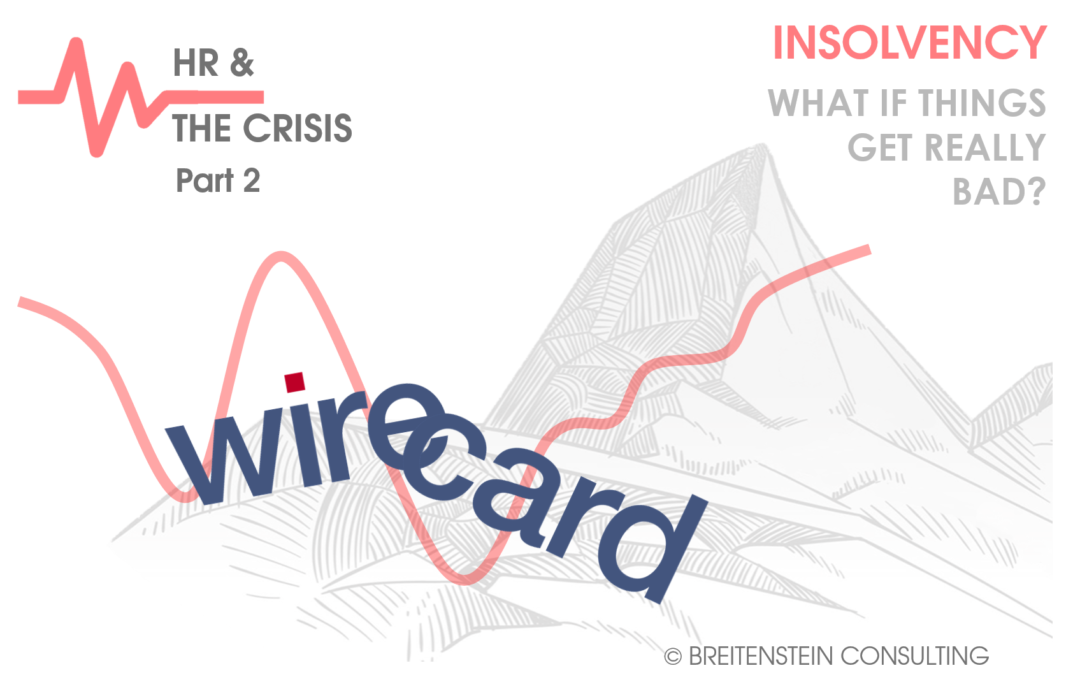What if dealing with the operational consequences of the global pandemic is suddenly the least of your problems? WIRECARD is certainly one of the most spectacular economic thrillers of the post-war period – right in the middle of the Corona crisis. Anyone who has witnessed it from an inside perspective has certainly been shaped for life. Annegret Jansen was in a leading position in HR at Wirecard – we at Breitenstein Consulting accompanied Wirecard in a project at that time. Here is a look at HR in the ultimate crisis situation and a few concrete lessons learned.
The ultimate horror scenario
With the global pandemic and the subsequent economic impact, some companies are suddenly confronted with the “final opponent” of insolvency. In recent decades, this has been more of a horror scenario that HR professionals know about in theory, but few have actually experienced firsthand.
Insolvency usually announces itself in some form – figures are bad, rumors are heard, the mood in the company changes and employees sense that something is wrong. Often the press helps with conjecture, and the rumor mill explodes. When it does, managers deny it, but there are suspicious ‘hedging’ activities that employees notice, leaving hardly any focus on any other topic in the company.
Then the shock: In most cases, you first learn about it from the external media: Insolvency has been filed and the company’s own management board is in jail. Confusion occurs without real statements from the responsible decision-makers – a leadership vacuum becomes noticeable. Any statement from top management is now legally sensitive.
Initial panic transpires, some even demonstratively play at normality – a sign of the refusal to face reality. On the one hand, there are the colleagues who are completely shocked, unable to think clearly, and who hope that they are only dreaming. On the other, there are colleagues who immediately send out 20 applications at random.
Employees are looking for the way to the personnel department. Who represents the company when no one else is there? Who can be approached with the questions that are now burning under everyone’s nails? There are two types of leaders in this situation: those who take the initiative, rally their people around them and do their best and fight – and then there are leaders who are so overwhelmed by their own frustration and fear that they lose sight of their team and their business. Those leaders run the risk of forgetting their role as employer representatives.
Insolvency affects EVERYONE in the company and HR is one of the first points of contact. So how do you, an HR manager, react if you have no information yourself? The first thing to do is to stay calm and spread the word. Be aware of your own emotions, reflect, listen and be approachable for colleagues and managers.
Questions that will undoubtedly come should first be received empathetically, even if they cannot be answered for the time being. Wirecard quickly set up a special e-mail box for this purpose. This way, the questions could be professionally received, structured, sorted and channeled. Typical questions are: Do we get a salary? What will happen to my vacation days? What happens next?
Many things are clear in terms of labor laws. The important thing now is to create trust. You can do this by communicating openly, being honest, not sugarcoating anything, and still not panicking. Don’t talk things down, but simply be present, show empathy, and keep your composure.
The insolvency machine starts up
If the application for insolvency is granted, a provisional insolvency administrator is appointed and takes the reins from that point forward. His/her main task is to “scan” the company and raise as much money as possible so that the creditors receive their outstanding payments and no further damage is caused to the remaining parts of the business. The activities of the insolvency administrators are not always transparent – this creates further mistrust. But for the time being they are also in the interest of the employees as priority creditors. The insolvency administrator tries to save as much as possible so that the business can be maintained. However, many employees are simply unaware of this – he or she is perceived as an adversary. It must be made clear that this is not the case. An insolvency administrator often does not have much time to communicate – this is where HR can take on a very important trustee function: Coordinate FAQ’s with each other and inform the employees, show empathy and again clearly maintain your stance.
HR also has a very formal main task in this phase: to provide and prepare data in a wide range of variants and depths for the insolvency administrator. A dilemma arises which can be perceived as very stressful: On the one hand, one is affected with all the consequences of insolvency, like everyone else in the company. On the other hand, one has to take care of an orderly and structured insolvency process. One asks oneself the question: Will I still get paid at all for the work I am doing now? Shouldn’t I also take care of my personal concerns first, instead of working evening shifts and processing data records? These questions take up space and leave no room for one’s own emotions and fears.
After the initial shock, anger and aggression arise in the workforce. Blame is assigned in all directions. Why is their own management so helpless, so uninformed? Why isn’t HR better informed? Frustration grows. For some groups of employees, special questions arise: for example, foreign colleagues who have to fear for their visas if they lose their jobs. Or employees on parental leave who call in with uncertainty. Many individual cases now have to be dealt with. The days are characterized by spontaneous data queries, employee resignations and countless calls and emails with detailed questions about individual situations. The insolvency administrator tends not to provide satisfactory answers about the desirable future, and it becomes clear that insolvency law is a complex universe and does not provide anything satisfactory that creates clarity about one’s own future.
As with an unclear medical diagnosis: Googling does not help any layman and can even increase frustration.
That’s why it’s so important to explicitly answer the questions you can. Every little bit of clarity about a process, the next steps or another appointment creates a bit of psychological security. Openly accessible FAQs have become established, where you can bundle recurring questions and regularly add new information. This is best done on the intranet but can also be done proactively as an e-mail blast if employees have been released or have already resigned (note: coordinate every communication with the insolvency administrator). Here, too, speed counts by surfing ahead of the rumor wave (instead of being buried by it).
Activity against feelings of insecurity
Participation creates self-efficacy, which generates security. Many people know the effect from rafting: when you float down a river in an inflatable boat, you have to row together in order to be faster than the water and steer properly. This activity needs to be coordinated. In the process, people develop a sense of togetherness that strengthens and makes each individual safe. That old change formula applies here, too: Activate people.
There is a lot of administrative work to be done, especially in insolvency proceedings. Whether internally or externally in the direction of the market, customers or the suppliers.
People who use their pent-up adrenaline for activities are less aggressive and more confident than those who brood on their jobs. This energy needs to be harnessed. That means talking through a to-do list with the insolvency manager, finding “manpower”, then delegating and motivating people! Even if you can’t give customers and suppliers satisfactory answers, contact and open ears are important in order to model the empathy that you would like to see in this situation. Experience shows that such behavior increases the understanding and tolerance of the business environment.
Holding key competencies – holding managers accountable
Clear to all: In this situation, nothing can be guaranteed. This applies to both the immediate and long-term future. Especially the top performers quickly find new jobs even in the crisis and are usually quickly approached by headhunters. A poaching of critical experts can often further seal the end of a company. Insolvency proceedings protect many vulnerable positions in a company – but not these. It is an important task for HR to bring a little relaxation into this, because these top performers are also very important motivators for the rest of the workforce. In concrete terms, this means identifying key know-how carriers. These do not always have to be managers. It is important to make a plan for these people: who talks to them – who keeps in touch?
Managers must be made aware of this role and, if necessary, be supported in exactly how they can talk to their teams and what they are allowed to say and what they are not. The goal must be to avoid panic or blind actionism. An important argument against flight movements is to make it clear that the good opportunities on the labor market will not be gone any time soon. That a caesura like this can perhaps first be used for self-reflection, that it may be worthwhile to fight for the company and that this may pay off later on an individual basis. Crises often reveal strong characters with leadership potential. An important message!
A test for HR as a team
Insolvency proceedings are also a challenge for HR as a whole team. Transparency is the key here. Nothing is perceived as worse than when your own colleagues within the team have more information than you do. This immediately stirs up fears, worries and mutual mistrust. This gives rise to rumors, and motivation declines further. In order for the HR team to function fully, maximum transparency must be ensured. Everyone must know what news there is (even if there is NONE), because everyone is approached by different employees. Everyone is also aware of the different moods of the workforce. HR must become a safe haven for reliable information. Disseminating information to the team takes additional time. A 15-minute sprint meeting every morning can be an essential success factor. New tasks can also be coordinated quickly here.
Many employees need an interim report or other documents immediately. Here, too, colleagues from other HR departments have to help. Under normal circumstances, one writes to the HR department about 20 references per month, suddenly 200 colleagues simultaneously ask and cannot understand why their request is not processed immediately.
The HR team is bombarded with many detailed questions. Here it helps to protect the experts in HR by providing as much general information as possible and having colleagues familiarize themselves with “non-specialist” details so that even those who are not “experts” can provide first level support. The experts (e.g. colleagues in payroll, employment lawyers) are involved in time-critical topics that only they can deal with.
Our lesson: streamline processes (e.g. only one signature instead of two, etc.) so that there are no delays. The speed that is sometimes needed cannot be guaranteed with lengthy “we’ve always done it that way” processes. It is a matter of concentrating on the essentials.
In an insolvency, everyone from HR is needed.
Even if, as in the case of Wirecard, the insolvency leads to the most extensive dissolution of the organization, the experiences of such weeks are formative and valuable. They show how essential human resources can be in a crisis situation.
This requires a new self-image for one’s own profession in which the administrative corset must be discarded.

Annegret Jansen
Former Head of Learning and Development at Wirecard
Alexander Gisdakis
CEO and Partner at Breitenstein Consulting



Recent Comments